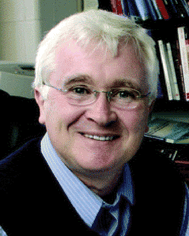Protein posttranslational modifications: Chemistry, biology, and applications
Hening
Lin
a and
Tadhg
Begley
b
aDepartment of Chemistry and Chemical Biology, Cornell University, Ithaca, NY 14853, USA
bDepartment of Chemistry, Texas A & M University, College Station, TX 77843-3255, USA
 Hening Lin | Hening Lin received his BS from Tsinghua University, Beijing, China in 1998 and his PhD from Columbia University in 2003. Following his postdoctoral training at Harvard Medical School, he has been an Assistant Professor at the Department of Chemistry and Chemical Biology, Cornell University, since 2006. His research focuses on enzymes that have important biological functions, particularly those that consume nicotinamide adenine dinucleotide. |
 Tadhg Begley | Tadhg Begley received his BSc from the National University of Ireland in 1977 and his PhD from Cal Tech in 1982. Postdoctoral studies at the University of Geneva and MIT were followed by his joining the Cornell Faculty in 1986. In June 2009, he moved to the Chemistry Department at Texas A&M University as the Barton Professor of Chemistry. His research is focused on the mechanistic enzymology of complex organic transformations and he has been a member of the Molecular BioSystems Editorial Board since 2005. |
The genome of a cell provides a basic blue print for the synthesis of proteins needed for the cell to survive, proliferate, and carry out its function. A human cell contains roughly 25
![[thin space (1/6-em)]](https://www.rsc.org/images/entities/char_2009.gif) 000 genes. However, the simple “one gene one protein” model is not adequate to describe the complexity of the proteins that are derived from these ∼25
000 genes. However, the simple “one gene one protein” model is not adequate to describe the complexity of the proteins that are derived from these ∼25![[thin space (1/6-em)]](https://www.rsc.org/images/entities/char_2009.gif) 000 genes. The complexity at the protein level comes from several sources. First, the transcription of DNA to mRNA is tightly controlled so that different genes are transcribed in different types of cells. Second, mRNA can be spliced differently, leading to different isoforms of a protein. Last but not least, proteins can be modified in various ways after they are translated. The posttranslational modification of proteins is the topic of this themed issue of Molecular BioSystems.
000 genes. The complexity at the protein level comes from several sources. First, the transcription of DNA to mRNA is tightly controlled so that different genes are transcribed in different types of cells. Second, mRNA can be spliced differently, leading to different isoforms of a protein. Last but not least, proteins can be modified in various ways after they are translated. The posttranslational modification of proteins is the topic of this themed issue of Molecular BioSystems.
Compared with other ways to regulate proteins, posttranslational modifications have unique features that provide certain advantages. Compared with regulation at the transcriptional level, posttranslational modification is faster, allowing a fast response to intracellular or extracellular signals. Many posttranslational modifications are reversible and thus can provide convenient control of protein structure and function with very small modifications. In addition, posttranslational modifications can add functional groups that are not available in the 20 amino acids that are commonly used in protein synthesis. The addition of functional groups allows enzymes to do chemistry that is otherwise difficult.
The versatility of posttranslational modifications is utilized extensively by cells to regulate or control many different biological pathways. Correspondingly, many posttranslational modifications are considered important targets for treating human diseases. Kinase inhibitors (e.g. Gleevec), protease inhibitors (e.g.. Saquinavir), and protein deacetylase inhibitors (e.g. Vorinostat) are clinically used drugs to treat several human diseases.
The importance of protein posttranslational modifications has attracted continuous research interest, particularly among chemists that are interested in biological problems. This themed issue aims to capture some of the popular trends in this area of research, including work from many young investigators. Many posttranslational modifications involve interesting chemistry/enzymology. Therefore, enzymologists are attracted by posttranslational modifications. This issue includes a review article by Davidson on the chemistry of generating protein-derived redox cofactors by posttranslational modifications (DOI:10.1039/c005311b) and an article by Zhu et al. on the chemistry of diphthamide modification on translation elongation factor 2 (DOI:10.1039/c0mb00076k). Due to the complexity of posttranslational modifications in physiology, chemical tools that can help to study posttranslational modifications are very useful. In this direction, Zhang and coworkers report a method to visualize protein kinase activity in plasma membrane microdomains (DOI:10.1039/c0mb00079e); Thompson and coworkers have developed a combinatorial approach to study protein arginine methyltransferase (DOI:10.1039/c0mb00015a); Hang and coworkers have developed reporters for detecting protein S-prenylation in cells (DOI:10.1039/c0mb00183j); and Liu provides a review on methods to prepare proteins with defined modifications that can be used to study the effect of modifications on the structure and function of proteins (DOI:10.1039/c0mb00216j). The medicinal relevance of posttranslational modifications suggests that activity assays and methods to manipulate enzymes that control posttranslational modifications will be useful for drug development. In this issue, Zheng reviews how sirtuins, a class of enzymes that can catalyze the deacetylation of protein lysine residues, can be inhibited by mechanism-based inhibitors (DOI:10.1039/c0mb00033g); Bi and coworkers report the development of an activity assay for cellular deacetylase activity that will be useful for examining deacetylase inhibitors (DOI:10.1039/c0mb00026d); with the aim of producing natural product-like drug molecules, Kelly and coworkers describe the biosynthetic engineering of thiostrepton, a natural product that is made by numerous posttranslational modifications (DOI:10.1039/c0mb00129e).
We hope this themed issue will capture the trends of chemical biology research in posttranslational modifications, highlight exciting new opportunities for research, and inspire more young investigators to contribute to the understanding of this important area.
| This journal is © The Royal Society of Chemistry 2011 |
